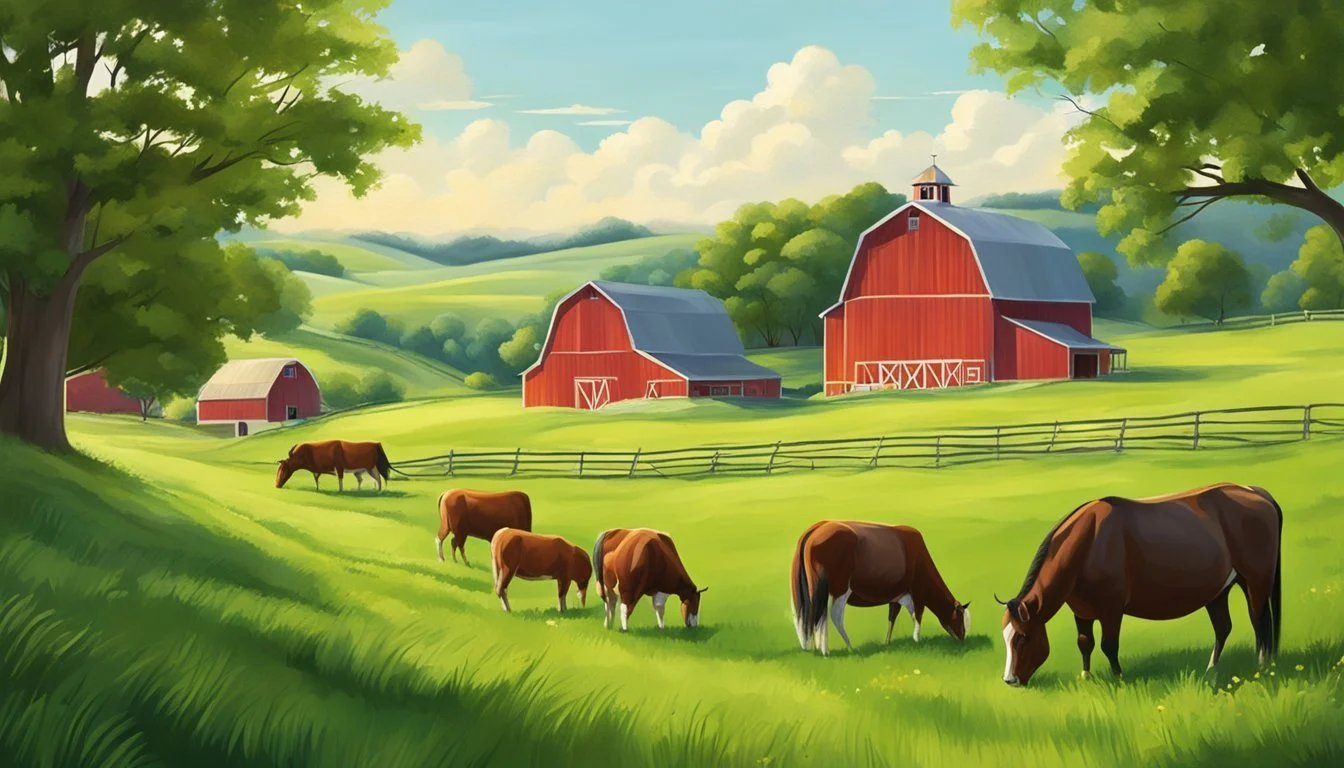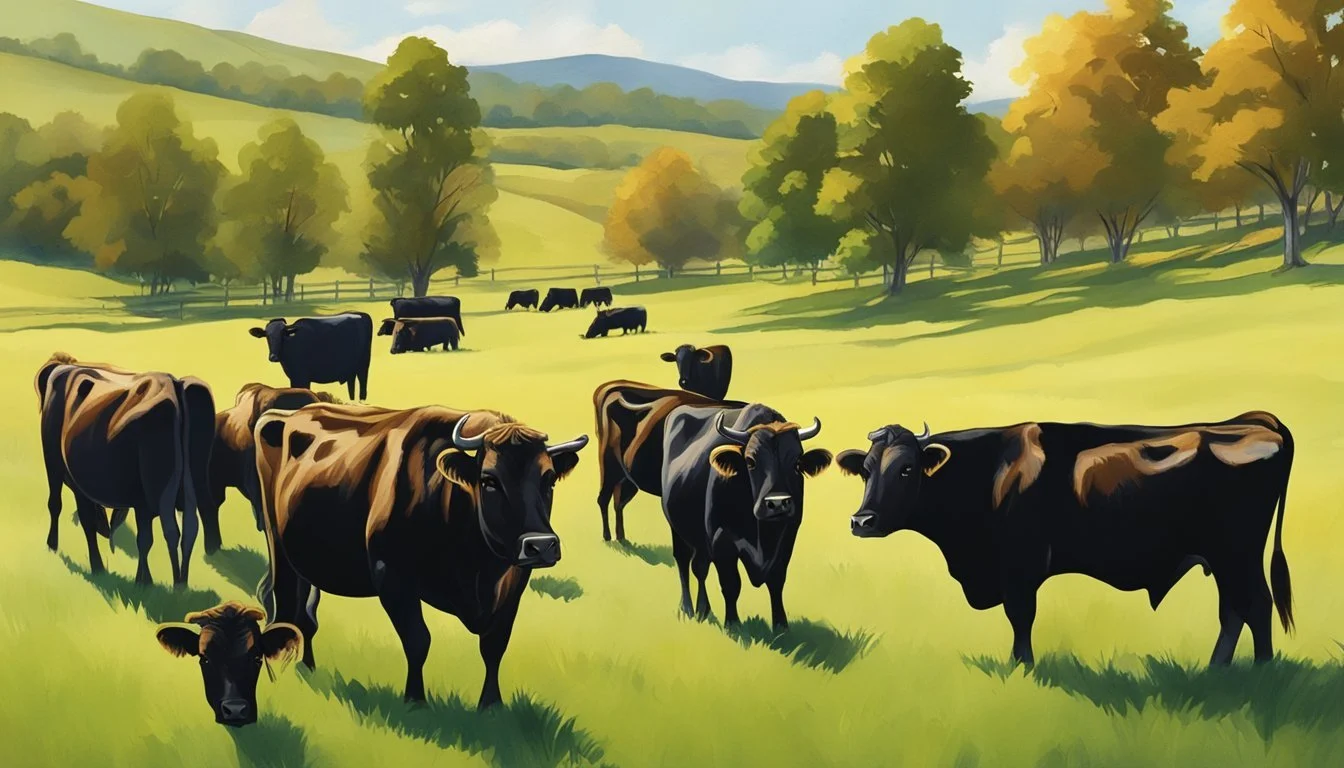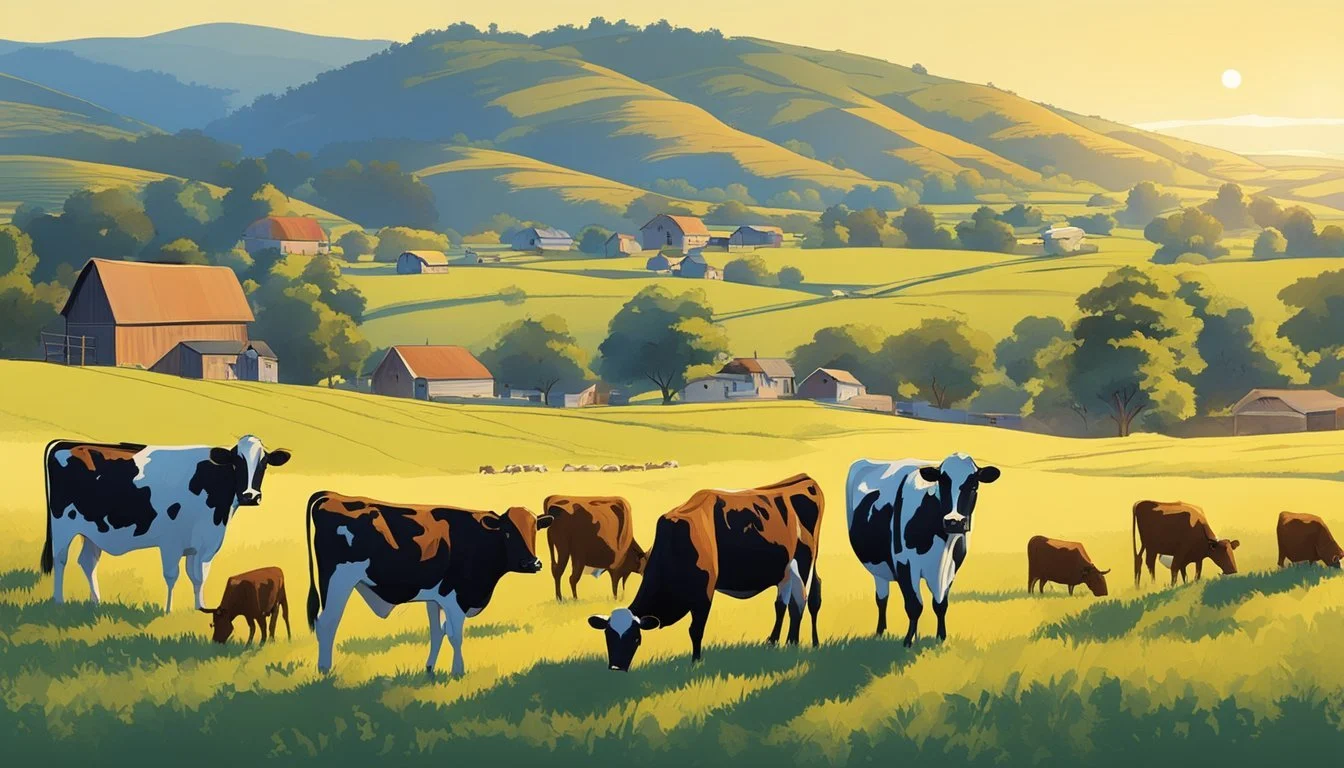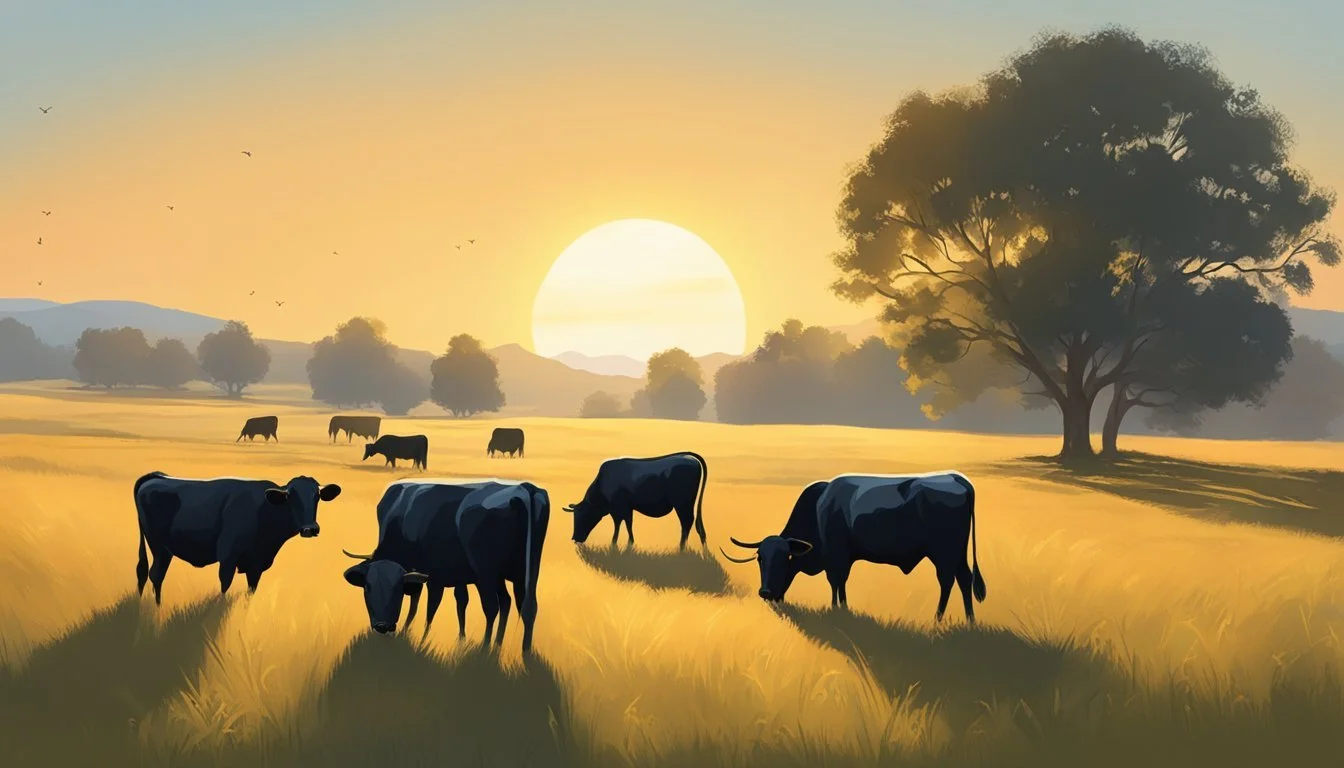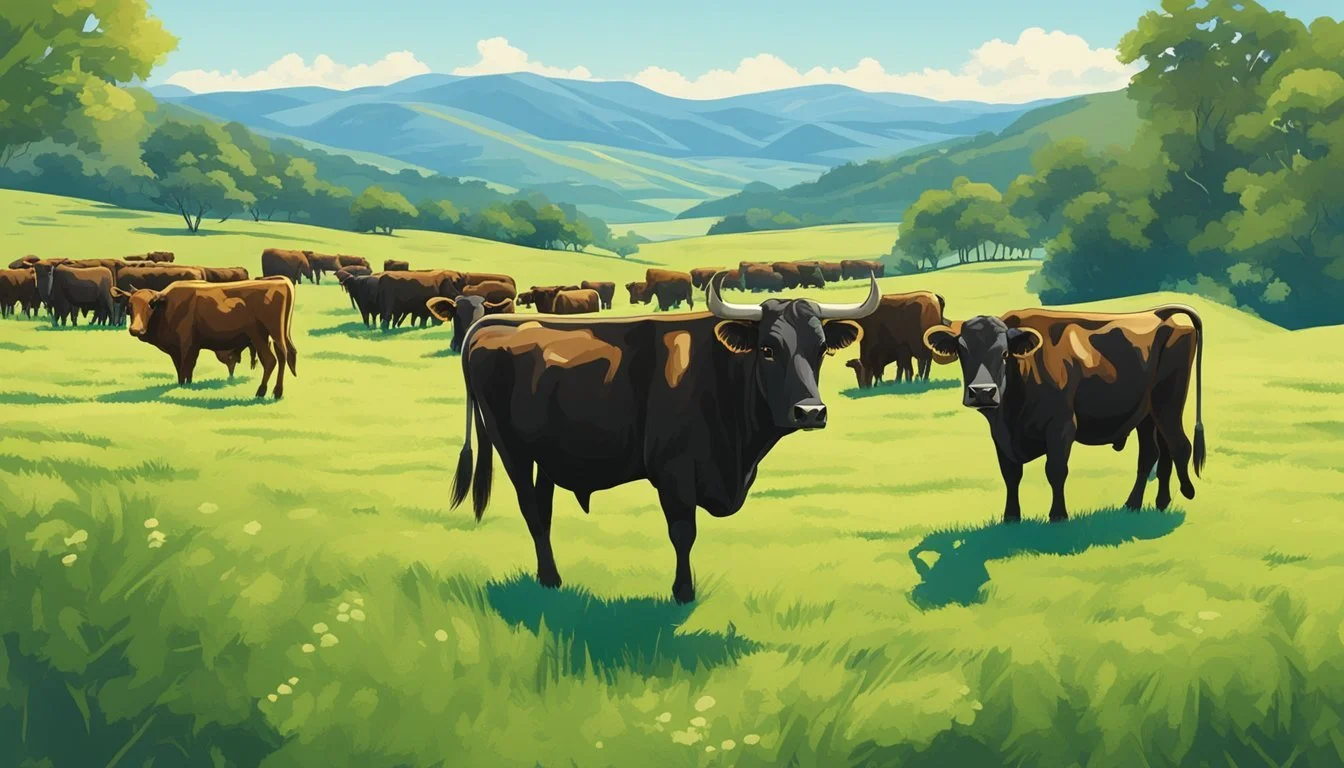Dexter Cattle Photography
Techniques for Stunning Herd Images
Dexter cattle, a breed that traces its origins to Ireland, have become a staple on farms large and small due to their manageable size and dual-purpose qualities for both meat and milk. Their distinctive features and compact physique not only make them ideal for small holdings but also present unique photographic opportunities. With expressive faces and a demeanor that ranges from the serene to the playful, Dexter cattle can provide a wealth of engaging moments for the camera.
Photographing these animals requires an understanding of their behavior as well as the technical aspects of photography. The best images of Dexter cattle often arise from natural light, particularly during the so-called golden hours of sunrise and sunset when the light casts a warm, illuminating glow. Overcast days, too, are perfect for photography, offering soft light that accentuates the cattle’s features without harsh shadows.
Capturing the essence of Dexter cattle through the lens is about more than just documenting their presence on a farm. It's about highlighting their individuality, showcasing their role in sustainable farming, and creating visual stories that resonate. With the right approach, photographers can convey not just the beauty of these animals, but also the important role they play in the diverse tapestry of agriculture.
Discovering Dexter Cattle
In the journey of cattle photography, the charm of Dexter cattle stands distinct. They are not only the smallest European breed but also carry a rich history and unique characteristics that make them a captivating subject for photographers.
History and Origin of Dexter Breed
The Dexter breed traces its roots back to Ireland. Recognizable for their compact stature, Dexters share a lineage with the Scottish Highland cattle. Initially bred for their size to work small Irish properties, the breed swiftly gained popularity due to its efficiency and dual-purpose nature, providing both milk and meat. By the early 20th century, the dedication to the breed led to the establishment of dedicated societies aimed at preserving and promoting Dexter cattle.
Characteristics of Dexter Cattle
Physique and Appearance: Dexter cattle display a broad body with well-rounded hindquarters, and they come in three primary colors: black, red, and dun. They are uniquely sized; small stature yet wide-bodies, standing out as a distinguishing feature among cattle breeds.
Temperament and Utility: Their temperament is typically docile, making them a preferred breed for small-scale farming. This coupled with their dual-purpose nature—apt for both dairy and beef production—further cements their reputation as a versatile breed. Dexter cattle are hardy, adapting well to various climates, which contributes to their popularity in conservation and rewilding projects.
The breed was originally horned, but many Dexters are now naturally polled, meaning they are bred without horns, which is a trait sought after for safety and convenience in handling. The breed's small size and efficient grazing habits also make them a sustainable choice for farming, necessitating less feed compared to larger cattle breeds. Therefore, photographers often find Dexters grazing in picturesque settings that highlight their practicality and allure.
Raising Dexter Cattle
Raising Dexter cattle is an enriching experience for farmers seeking to produce quality meat or milk. These hardy animals are well-suited for smaller farms, offering advantages like dual-purpose utility and less intimidating handling due to their size.
Best Practices in Farming Dexter Cattle
Dexter cattle are a versatile breed, ideal for varying climatic conditions and are adept at grazing on pastures. For optimal growth and health, they can be raised on a pasture-based diet with occasional grain supplementation if necessary. This breed generally requires less feed than larger cattle breeds, providing a cost-effective option for farmers. Important farming practices include:
Regular health checks to prevent diseases and maintain herd well-being.
Rotational grazing to ensure sustainable pasture management.
Adequate shelter, particularly in regions with harsh weather conditions.
Provide sufficient space for calves to grow and females to exhibit natural maternal behaviors.
Understanding Dexter Cattle Temperament
Dexter cattle are known for their gentle disposition, making them excellent for family farms or homesteads. They typically display calm behavior, which allows for easier handling and minimizes the risk of injury to both the animals and their caretakers. When working with Dexters, gentle and consistent handling is paramount to maintain their trust and cooperation. Bulls, however, should be handled with caution as they can become more unpredictable, especially during the breeding season.
Health and Diseases in Dexter Cattle
Despite their hardiness, Dexter cattle can be susceptible to certain health conditions and diseases such as:
Pulmonary hypoplasia with anasarca (PHA): a genetic condition that can cause calving difficulties and result in a dead calf.
Fescue toxicity: can cause issues in pregnant females, such as poor weight gain and issues with milking.
To prevent health issues:
Ensure cattle receive vaccinations and parasite control.
Manage breeding carefully to avoid genetic diseases by maintaining a diverse pedigree.
Monitor body condition scores, especially during calving, to ensure cows and calves are at optimal health.
Provide nutritious hay during winter or drought when fresh pasture is not available.
Farmers should stay informed about local market trends to achieve favorable prices for Dexter beef or live animals, and prioritize the care of their Dexter stud for successful breeding outcomes.
Photography Tips for Dexter Cattle
Capturing the intrinsic charm of Dexter cattle requires a strategic approach to photography. This section offers practical tips on choosing the right equipment, composing striking images, and utilizing optimal lighting conditions to showcase your herd.
Equipment and Settings for Livestock Photography
Choosing the right camera equipment and settings is crucial for livestock photography. A DSLR or mirrorless camera with a high-quality telephoto lens (70-200mm) allows for sharp images even from a distance.
Aperture: Use a wide aperture (e.g., f/2.8 - f/4) for a shallow depth of field to make your subject stand out.
Shutter Speed: A faster shutter speed (at least 1/500th of a second) is ideal to freeze motion.
ISO: Keep the ISO as low as possible to avoid grainy images; adjust according to the available light.
Composing Shots with Dexter Cattle
Composition is key when photographing Dexter cattle.
Perspective: Shoot from eye level or lower to engage viewers and convey the stature of the cattle.
Background: Choose a background that doesn't distract from the subject. Natural settings work well.
Include the eye of the cattle in your shots as a point of focus; it brings life and emotion to the photo.
Lighting and Weather Considerations for Outdoor Photography
Understanding the role of natural light is fundamental in outdoor photography.
Golden Hour: Shoot during early morning or late evening when the light is soft and warm.
Overcast Conditions: Use cloudy days to your advantage; the diffused light provides even exposure and reduces harsh shadows.
Plan around midday photography sessions where light can be too harsh and unflattering, especially on sunny days.
Productive Farming with Dexters
Dexter cattle are a versatile breed, ideal for smallholding production due to their moderate size and efficient feed-to-product conversion. They're prized for their ability to produce quality milk and meat on smaller acreages.
Utilizing Dexter Cattle for Milk Production
Dexter cattle are renowned for their high-quality milk which contains A2 protein, making it easier to digest for some consumers. A typical Dexter cow can yield around 1.5 to 2.5 gallons of milk per day. Their milk also boasts a higher butterfat content, averaging at about 4.0%, which makes it particularly suitable for butter and cheese production. Heifers can be bred at a younger age compared to larger breeds, which means milk production can begin sooner, improving overall productivity on the farm.
Dexter Cattle in Meat Production
In the realm of beef production, Dexter cattle's small size yields a carcass with a higher proportion of premium cuts of meat such as rib and loin. Grass-fed Dexter beef is often marketed for its grass-fed quality, which is associated with health benefits and a more sustainable farming practice. Harvested typically at a live weight of 750 to 900 pounds, Dexters produce lean, well-marbled beef that's sought after for its flavor and tenderness.
Grazing Patterns and Feed Management
Dexter cattle are adept at making the most of pasture and can thrive on forage that might not sustain larger breeds, which translates to cost savings and improvement in land management. Dexter cattle require less feed than larger breeds, which is a significant advantage for smallholders. Oats, among other grains, can be a beneficial addition to their diet during the winter or to supplement pasture during the growing season. Dexter cows adapt well to rotation grazing, helping to maintain the health and sustainability of the pasture.
Breeding and Genetics
The breeding and genetics of Dexter Cattle are foundational to maintaining the quality and health of the herd. Precise breeding programs and understanding of genetic traits ensure the longevity and purity of the Dexter bloodlines, while attention to calves and heifers contributes to the herd's future robustness.
Breeding Programs for Dexter Cattle
Breeding programs for Dexter Cattle focus on genetic diversity and herd improvement. Dexter studs are scrutinized for traits that align with breed standards, such as uniformity in size and conformation. Belle Fourche Farm is known for its exemplary Dexter breeding bulls, and their programs often serve as models for achieving high-quality Dexter beef.
Genetic Traits and Hereditary Conditions
Dexter Cattle carry specific genetic traits that are both beneficial and detrimental. The breed can exhibit chondrodysplasia, a form of dwarfism known locally as 'chondro'. Breeders must test for this trait, as homozygous carriers can lead to health issues. On the positive side, Dexters are often celebrated for their hardiness and adaptability, traits selectively enhanced through careful genetic management.
Preserving Dexter Cattle Bloodlines
Preserving Dexter Cattle bloodlines relies on meticulous record-keeping and adherence to pedigree integrity. It's crucial to maintain a Dexter cattle breed registry to track breeding, prevent inbreeding, and guide decisions on genetic pairings that promote the vitality of the bloodlines. Breed associations provide resources to support these efforts.
Managing Calves and Heifers
Management of calves and heifers is key for the continuation of the breed's genetic line. Bulls and heifers selected for reproduction are evaluated for genetic conditions, performance metrics, and pedigree. For example, belle fourche MRald Overture is a sire name often seen in Dexter pedigrees, associated with desirable genetic qualities. Annual health check-ups and rotational breeding are methods to manage and maintain the overall hereditary health of the herd.
Dexter Cattle and Sustainable Farming
Dexter cattle play a pivotal role in sustainable farming due to their adaptability and efficiency. They make a significant impact on eco-friendly farming practices and benefit smallholding operations with their compact herd size.
Role of Dexter Cattle in Eco-Friendly Farming Practices
Dexter cattle are renowned for their hardiness, making them ideal for pasture-based systems which are central to sustainable agriculture. They are adept at converting forage into high-quality beef and milk, which is particularly beneficial for smallholdings. The versatility of Dexter cattle allows them to thrive in various environmental conditions, reducing the need for artificial inputs and supporting the farm's ecological balance.
A2 Protein Production: Dexters are also known for their ability to produce milk rich in A2 protein, considered by some as a healthier alternative, thus catering to niche markets and promoting diverse farming income streams.
Integration with Other Livestock: Their small size and gentle demeanor allow them to graze alongside other animals, such as sheep, optimizing pasture use and encouraging biodiversity.
The Benefits of a Compact Herd Size
Dexters’ small stature leads to numerous benefits conducive to sustainable farming:
Land Efficiency: A smaller breed requires less space, enabling farmers to maintain a productive herd on limited acreage, which is a cornerstone of many homesteads.
Lower Resource Footprint: The compact size of Dexters results in less feed consumption and minimal land impact compared to larger cattle breeds, thus supporting a sustainable farm operation.
Additionally, organizations like the Dexter Cattle Society provide support and resources to Dexter owners, promoting best practices that enhance the breed's contributions to sustainable agriculture.
Marketing and Economics of Dexter Cattle
Dexter cattle possess unique qualities that make them a viable option for niche markets. Their small size and dual-purpose nature allow for both milk and beef production, providing diverse revenue streams for farmers.
The Dexter Cattle Market
The Dexter cattle market is specialized, catering to smaller-scale beef producers and hobbyists. Dexter beef is known for being slightly darker with good marbling and a fine-grained, tender texture. This quality fetches a premium in specialized beef markets. When selling Dexter cattle, it's beneficial for the farmer to dehorn, vaccinate, castrate, and wean calves at least two weeks before the sale to garner better prices. Sizes and ages should be grouped appropriately, with current local market prices frequently checked for competitiveness.
Typical price range for bottle or bucket calves: $1.50 per lb live weight (prices may vary)
Important pre-sale preparations: Dehorning, vaccinating, castrating, weaning
Starting a Dexter Cattle Farm as a Business Venture
An individual considering starting a Dexter cattle farm should conduct thorough market research to understand demand. An effective way to reach potential customers is through direct marketing channels, which include social media platforms, agricultural trade shows, and creating an email list for newsletters. Prospective farmers should connect with Dexter cattle associations for support and networking opportunities, which can help gain market insights and promote Dexter cattle and beef.
Key business venture considerations:
Market research: To understand the potential demand for Dexter cattle and beef
Networking: Build relationships with associations and potential buyers
Email marketing: A cost-effective way to reach a targeted audience
Costs and Revenue from Dexter Cattle Operations
To gauge the profitability of Dexter cattle operations, one must understand both the costs of raising the cattle and potential revenue from sales. Costs typically include feed, veterinary care, and land management. Dexter cattle are smaller and may consume less feed than larger beef breeds, potentially reducing the feed costs. Revenue streams come from selling beef, breeding stock, and potentially milk.
Operational costs and considerations:
Land management: Essential for optimal cattle health and productivity
Feed: Smaller breed, so potentially less feed required
Veterinary care: Regular check-ups and vaccinations
Revenue potential from:
Dexter beef sales: Premium market for high-quality beef
Breeding stock: Sale of calves and mature cattle
Dairy products: If milk production is incorporated into the operation
By focusing on market dynamics, starting a venture judiciously, and managing the economics effectively, Dexter cattle can be a profitable addition to a farming operation.
Beyond the Farm: Dexter Cattle Community
Dexter Cattle enthusiasts extend far beyond individual farms, with a vibrant community of breeders and exhibitors sharing knowledge, resources, and their passion for the breed.
Networking and Building Relationships with Other Breeders
Successful breeding programs hinge on the sharing of genetics, expertise, and experiences. Breeders often connect through organizations such as the Dexter Cattle Society. It offers a platform for members to exchange best practices and provides access to a wealth of resources, from genetic data to herd management tips. Belle Fourche Farm has set a standard in this regard, not just by developing outstanding Dexter Cattle but also by serving as a network node for fellow breeders.
Key benefits of networking:
Genetic diversity through shared breeding stock
Mentorship opportunities for new breeders
Strengthening the breed's characteristics and health
Events and Shows: Showcasing Excellence
Dexter cattle shine at events and shows, where excellence in conformation, temperament, and breed characteristics is celebrated. Such events offer breeders the chance to highlight their herd's quality, as well as to garner recognition. A notable example would be Mrald Overture, a Dexter that has gained acclaim for its exceptional traits. Shows act as catalysts for setting breed standards and inspiring breeders to aim for excellence.
Types of events include:
Local and regional Dexter cattle shows
National exhibitions and competitions
Educational seminars and workshops
Participation in these events not only showcases dedication and prowess but also fosters a sense of community among Dexter cattle enthusiasts.
Dexter Cattle Care and Maintenance
When raising Dexter cattle, it's essential to establish a suite of care routines and provide appropriate infrastructure to ensure the health and comfort of the herd.
Daily Routine and Husbandry Practices
Observation: Caregivers should start each day with a thorough visual inspection of the cattle to check for any signs of illness or injury.
Feeding: Dexter cattle, known for their ability to thrive on pasture, require consistent access to quality forage. During grazing off-seasons, hay or silage supplementation is often necessary.
Milking: For those milking their Dexters, a clean and calm environment is crucial. Since they're small and generally calm, they can be easier to handle than larger breeds.
Health checks: Routine examinations should focus on areas like the udder health of heifers, particularly around calving times, to prevent mastitis.
Documentation: Keeping accurate records of all aspects of their care, including breeding and health interventions, is integral.
Infrastructure and Shelter Requirements
Fencing: Robust fencing is important to safely contain Dexter cattle, taking into account their smaller size compared to other breeds.
Shelter: While Dexters are hardy and can cope with various climates, they will still need shelter from extreme weather. This could be a dedicated barn or natural shelter like tree cover.
Space: Dexter cattle can be raised on smaller plots of land, often sharing space with other farm animals such as sheep, provided there's adequate room for grazing and exercise.
Handling facilities: Safe and accessible handling facilities are important for both routine and special care events, such as veterinary visits or calving assistance.
Complementary Farming: Dexter Cattle with Other Animals
When integrating Dexter Cattle with other farm animals, such as pigs and sheep, smallholders can optimize forage use and benefit from multi-species grazing practices. These synergies can lead to a more sustainable and productive farming operation.
Mixed Farming: Integrating Cattle with Pigs and Sheep
Dexter cattle are known for their relatively small size and versatility, traits particularly beneficial for mixed farming. They are commonly integrated with other farm animals, including pigs and sheep. Such integration allows for a more efficient utilization of available resources. For instance, Dexters graze on forages, while pigs can root and consume waste products, and sheep can graze on the forages that cattle do not prefer.
Pigs: They contribute to the farm ecosystem by naturally tilling the soil, which can aid in the control of parasites that might otherwise affect the cattle.
Sheep: These animals often have different grazing habits compared to cattle. By grazing alongside Dexter cattle, sheep can help control weeds and ensure a more uniform grazing of the pasture.
Benefits of Multi-Species Grazing
Multi-species grazing offers a range of benefits:
Optimized Forage Use: Diversified grazing patterns can lead to more complete forage use, reducing waste and encouraging pasture regrowth.
Parasite Management: The life cycles of parasites are often species-specific. Grazing sheep and cattle together disrupts these cycles, which can help reduce the parasite load for both animals.
Increased Biodiversity: The presence of different species promotes a varied ecosystem, which can contribute to soil health and reduce the risk of disease.
Dexter Cattle as Working Animals
Dexter cattle possess characteristics that facilitate their use beyond meat and milk production, specifically in their capacity as draft animals suited to various homestead duties.
Utilizing Dexter Cattle as Draft Animals
Dexter cattle readily serve as draft animals on smaller farms. Their compact size and gentle disposition render them ideal for this work. Homesteaders value Dexter cattle for their versatility in roles commonly filled by larger equines.
Key characteristics of Dexter cattle as draft animals include:
Size: Small stature eases maneuverability and reduces the space needed for housing.
Strength: Sufficient power allows them to handle pulling carts and plowing fields.
Training and Handling for Farm Work
Training a Dexter for draft work starts with basic handling while they're calves. Dexter cattle's docile nature often makes them receptive to training, as they can be taught to respond to vocal cues and light touches for direction.
Essential training steps include:
Habituation: Acclimatize the Dexter to harnesses and yokes slowly.
Consistency: Regular, positive training sessions build trust.
Pairing: Work them alongside an experienced Dexter stud to learn by example.
Properly trained, Dexters can bring significant value to farm work through their dual purpose as both draft animals and producers of meat and milk.
Conclusion
Photographing Dexter cattle can be a rewarding endeavor that effectively showcases their unique characteristics. These small, hardy animals present a variety of photographic opportunities. When capturing images of Dexter cattle, it is essential to consider the following points:
Lighting: Utilize natural light to accentuate their coats, which come in black, dun, and red.
Composition: Frame the cattle against pastoral backdrops to emphasize their role in sustainable agriculture.
Behavior: Capture their gentle dispositions, which is a trait well-noted for Dexters.
Details: Highlight the breed's notable features, like well-rounded hindquarters and broad bodies, in your shots.
When photographing these animals, photographers must respect their environment and space. Obtaining high-quality images of Dexter cattle not only contributes to the breed's promotion but also serves as a testament to their versatility and suitability for small-scale farming. Properly executed, cattle photography elevates the visibility of this breed and informs both the farming community and the general public of their valuable attributes. Overall, whether for hobbyists, breeders, or conservationists, Dexter cattle photography holds a place of importance in both agricultural advocacy and visual storytelling.




